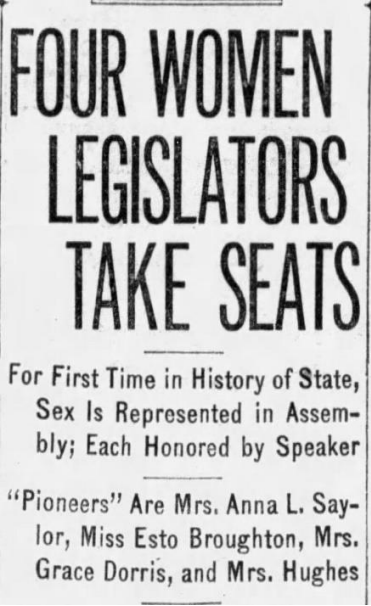Press Release
2022 Election
California Women Shatter Records in 2022 Elections
California Women Shatter Records in 2022 Elections
Sacramento – For the first time in California history, more than 200 women ran for state
and federal offices in an election cycle, and a record number of them will occupy seats in the 2023-24 California Legislature when they are sworn in next week, according to a vote analysis by The Friends of California Archives, a nonprofit organization dedicated to promoting the use of the collection of the state’s historical records.
With votes still being counted from the 2022 general election, the female contingent in the
Legislature is approaching 50, a dramatic increase from the high-water mark of 39, set during the
current legislative session.
In addition, gender parity will continue for another four years in the state’s eight statewide
constitutional offices.
Newly elected Controller Malia Cohen will join Lt. Governor Eleni Kounalakis, Treasurer Fiona Ma and Secretary of State Shirley Weber, who easily won election victories.
In races for the House of Representatives, however, California’s female representation will drop from its current 20 members to 17, due in large part to the retirements of Connie Conway, Lucille Roybal-Allard and Jackie Speier, who will be replaced by men.
California also lost one seat after the2020 Census.
One woman, Sally Lieber, was elected to the State Board of Equalization, and Dianne Feinstein remains in the U.S. Senate.
“California voters elected the first four women to the Assembly in 1918, seven years after
the all-male electorate authorized female suffrage in the state, yet still two years before the 19th Amendment gave women the right to vote in America,” said Caren Daniels Lagomarsino, president of The Friends of California Archives. “It has been an uphill battle ever since. Overall, gender parity has been an elusive goal. In fact, there were many years – even as late as the dawn of the modern women’s movement in the 1960s –when only a single woman held a California state or federal office. This session’s victories deserve to be recognized and celebrated.”
Academic studies have found a significant gender gap in political ambition, with women tending to be more risk-averse than men, more resistant to the negativity of politics, more prone to be held back by childcare and household responsibilities, and more uncomfortable asking for the campaign donations that are necessary to win competitive seats. Still, said Jennifer Lawless, former director of the Women and Politics Institute at American University, “when they do run, female candidates do just as well as men.”
Highlights from the Election Records Preserved in the California State Archives

San Francisco Examiner
January 7, 1919
• 1911: Women gain the right to vote in California;
• 1918: Anna Saylor, Esto Broughton, Elizabeth Hughes, and Grace Dorris are the first women
elected to the California Assembly;
• 1922: For the first time, five women are elected to the Assembly;
• 1923: Mae Nolan wins a special election to succeed her husband, becoming the first California woman to be elected to Congress;
• For six years during the 1960s, Assembly member Pauline Davis is the only woman to serve in any of California’s state or federal offices;
• In the combined five election cycles during the 1950s, only 90 California women run for
state or federal office;
• 1966: Ivy Baker Priest (Treasurer) is the first woman elected to a statewide constitutional
office; March Fong and Yvonne Brathwaite become the 13th and 14th women elected to
the Assembly. Fong is the first Asian-American woman and Brathwaite is the first African American woman elected to the Legislature;
• 1974: March Fong Eu is elected California’s Secretary of State and the first Asian-American
woman elected to a statewide elected office in the nation;
• 1976: Rose Ann Vuich is the first woman elected to the State Senate; a record six women
are elected to the Legislature;
• 1982: Gloria Molina is the first Latina elected to the Assembly;
• 1987: Nancy Pelosi wins a special election to the U.S. House and is elected the first woman
Speaker of the House (2007 – 2011 and again 2019 – present);
• 1990: Dianne Feinstein is the first woman to win a major party nomination for Governor;
• 1992: California is the first state to elect two female U.S. Senators;
• 1992: After redistricting and voter-approved term limits (1990) for state contests create a
more favorable political landscape, 199 women run for state and federal offices, a record
that stands for 30 years;
• 2010: Kamala Harris becomes the state’s first female Attorney General (in 2016, she wins a
seat in the U.S. Senate, and in 2020, is elected the nation’s first female and first African American Vice President); Meg Whitman is the third woman to secure a major-party
nomination for Governor;
• In the 2022 election cycle, a record 219 female candidates run in the combined contests for the state Legislature, U.S. House, statewide office (including U.S. Senate), and Board of
Equalization. Lagomarsino noted that The Friends of California Archives has published a children’s book to focus on the change-making women who broke barriers in California history in the fields of elections, professions, environment, education, economics, and race and culture. The Time Travelers is set in a fictional classroom but is based on actual women from California history.
